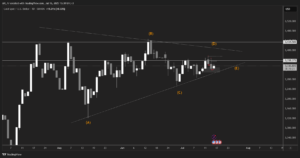After the bloodbath on Wall Street and as recession fears grow, European bourses point to a broadly weaker open ahead of the non-farm payroll.
· Inflation & stagflation fears pulled Nasdaq 5% lower yesterday & GBP/USD 2% lower
· DAX falls below 13900 as German data highlights the impact of the Russian war on the economy
· US non-farm payroll to show 390k jobs added
Stocks on Wall Street performed a spectacular reversal. After surging 3% post-Fed on Wednesday, stocks plunged lower yesterday as the markets reassessed the deteriorating economic picture and questioned the Fed’s ability to keep a 75 basis point rate hike off the table.
Inflation, stagflation, and even recession fears fuelled risk aversion yesterday, pulling European markets into the red after a stronger start to the day. The FTSE was an anomaly closing higher, but that was only due to the pound plunging 1.2350, a fresh 23-month low. The BoE hiked rates by 0.25% but warned that inflation would climb to 10% and forecast a contraction in 2023. Andrew Bailey gave the gloomiest outlook from any central bank so far this year, and the pound paid the price for it.
Fed Chair Powell, in comparison, sounds optimistic that a soft landing is still achievable. However, judging by yesterday’s 5% selloff in the Nasdaq and 3.5% drop in the S&P500, the markets are struggling to believe him.
GBP/USD has steadied around 1.2350, and the RSI is deeply in oversold territory, so there could be some consolidation around these levels before sellers look towards 1.2250, the June ’20 low.
German industrial production – DAX
German industrial production plunged by -3.9% MoM in March, after rising 0.2% in February and falling by more than the -1% forecast. The data comes after German factory orders tangled by a more than expected -4.7%. The data provides further evidence of how the Russian war is hitting the German economy and, more broadly, the European economy.
The DAX is set to fall 1.4% across this week, marking the fifth straight week of declines. Sellers will be looking for a move below 13500 for the bearish trend to continue.
NFP
Today all eyes are on the US labour market, which Fed Chair Powell said remains extremely tight. Today’s data is expected to support that comment, with 390k new jobs added in April, down from 431k in March. While this was slightly below the 490k forecast, it was more than made up for by an upward revision to the February print to 750k, from 678k.
April’s non-farm payroll could come slightly below forecasts, given that the leading indicators showed signs of slowing. That said, the JOLTS job openings rose to 11.5 million, a record high.
The unemployment rate is expected to remain steady at 3.6%, and wage growth is expected to creep higher to 5.6%.
There is still another non-farm payroll report to be released before the June Federal Reserve monetary policy meeting. Therefore the reaction to this jobs report could be more muted than usual.
Disclaimer: This article is not investment advice or an investment recommendation and should not be considered as such. The information above is not an invitation to trade and it does not guarantee or predict future performance. The investor is solely responsible for the risk of their decisions. The analysis and commentary presented do not include any consideration of your personal investment objectives, financial circumstances, or needs.





